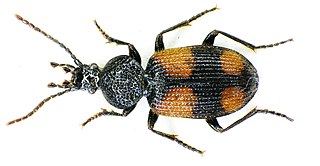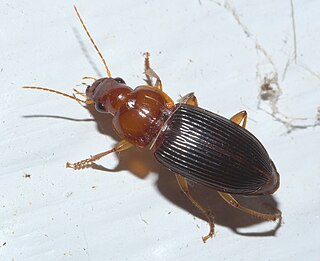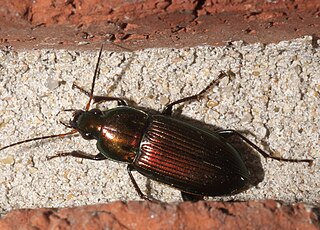
Franco Andrea Bonelli was an Italian ornithologist, entomologist and collector.

Ground beetles are a large, cosmopolitan family of beetles, the Carabidae, with more than 40,000 species worldwide, around 2,000 of which are found in North America and 2,700 in Europe. As of 2015, it is one of the 10 most species-rich animal families. They belong to the Adephaga. Members of the family are primarily carnivorous, but some members are phytophagous or omnivorous.

Amara is a large genus of carabid beetles, commonly called the sun beetles. Many are holarctic, but a few species are neotropical or occur in eastern Asia.

Harpalinae is a subfamily of ground beetles that contains more than 3,000 species in 4 tribes worldwide, according to the Carabcat Database. A rarely used common name for the subfamily is the harp beetles. The Harpalinae contain the most apomorphic ground beetles, displaying a wide range of forms and behaviors. Some are, rare among ground beetles, omnivores or even herbivores.

Cychrus is a large genus of rare snail-eating beetles in the family Carabidae. There are at least 160 described species in Cychrus. They are found throughout the world, although more than 80 percent of the species occur in China.

Chlaenius is a large and diverse genus of ground beetle. It is native to the Palearctic realm, Afrotropical realm, and Nearctic realm. Worldwide, roughly 1,000 species are currently recognized with the majority of known species occurring in the Oriental and Afrotropical regions. The genus is divided into many subgenera.

Brachininae is a subfamily of beetles in the family Carabidae.

Dryptinae is a subfamily of ground beetles in the family Carabidae. There are more than 30 genera and 570 described species in Dryptinae.

Lebiinae is a subfamily of ground beetles in the family Carabidae. There are more than 330 genera and 6,300 described species in Lebiinae, in 5 tribes.

Licininae is a subfamily of beetles in the family Carabidae, containing the following genera:

Panagaeinae is a subfamily of beetles in the family Carabidae. There are more than 30 genera and 400 described species in Panagaeinae.

Platyninae is a subfamily of ground beetles.

Pterostichinae is a subfamily of ground beetles. It belongs to the advanced harpaline assemblage, and if these are circumscribed sensu lato as a single subfamily, Pterostichinae are downranked to a tribe Pterostichini. However, as the former Pterostichitae supertribe of the Harpalinae as loosely circumscribed does seem to constitute a lineage rather distinct from Harpalus, its core group is here considered to be the present subfamily and the Harpalinae are defined more narrowly.

Scaritinae is a large subfamily of beetles in the family Carabidae, containing more than 2400 species in over 140 genera. They are found worldwide.

Trechinae is a subfamily of ground beetles in the family Carabidae. There are 6 tribes, more than 430 genera, and over 6,700 described species in Trechinae.

Harpalini is a tribe of a diverse group of ground beetles belonging to the subfamily Harpalinae within the broader family Carabidae. The tribe contains more than 1,900 species.

Platynini is a large tribe of ground beetles in the family Carabidae. There are at least 190 genera and 3000 described species in Platynini.

Zabrini is a tribe of ground beetles in the subfamily Pterostichinae of beetle family Carabidae, found mainly in North America and Europe. There are more than 750 described species in three genera of Zabrini, more than 600 of which are in the genus Amara.

Pterostichini is a tribe of ground beetles in the subfamily Harpalinae. There are about 180 genera and more than 3,800 described species in Pterostichini.



















